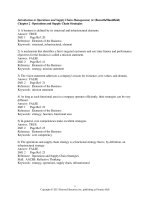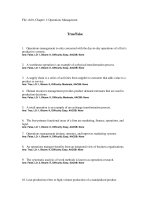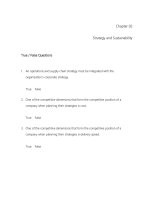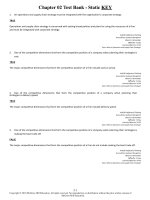Introduction to operations and supply chain management 3e bozarth chapter 01
Bạn đang xem bản rút gọn của tài liệu. Xem và tải ngay bản đầy đủ của tài liệu tại đây (228.43 KB, 17 trang )
Introduction to Operations and
Supply Chain Management
Chapter 1
Chapter Objectives
Be able to:
Describe what the operations function is and why it is critical to
an organization’s survival.
Describe what a supply chain is and how it relates to a
particular organization’s operations function.
Discuss what is meant by operations management and supply
chain management.
Identify some of the major operations and supply chain
activities, as well as career opportunities in these areas.
Make a case for studying both operations management and
supply chain management.
Copyright © 2013 Pearson Education, Inc. publishing as Prentice Hall
1-2
Why study Operations and
Supply Chain Management?
Every organization must make a product or a
service that someone values.
Most organizations function as part of larger
supply chains.
Organizations must carefully manage their
operations and supply chains in order to
prosper, and indeed, survive.
Copyright © 2013 Pearson Education, Inc. publishing as Prentice Hall
1-3
Operations Management
Operations Management – The planning,
scheduling, and control of the activities that
transform inputs into finished goods and
services.
© 2010 APICS Dictionary
Figure 1.1
Copyright © 2013 Pearson Education, Inc. publishing as Prentice Hall
1-4
Manufacturing
Tangible product
Key decisions driven by physical
characteristics of the product:
How is the product made?
How do we store it?
How do we move it?
Etc.
Copyright © 2013 Pearson Education, Inc. publishing as Prentice Hall
1-5
Services
Intangible Product or Service
Location, Exchange, Storage, Physiological,
Information
Key decisions:
How much customer involvement?
How much customization?
Copyright © 2013 Pearson Education, Inc. publishing as Prentice Hall
1-6
Supply Chain Management
Supply Chain Management – The active
management of supply chain activities and
relationships in order to maximize customer
value and achieve a sustainable competitive
advantage.
Copyright © 2013 Pearson Education, Inc. publishing as Prentice Hall
1-7
A Supply Chain Example
Figure 1.2
Copyright © 2013 Pearson Education, Inc. publishing as Prentice Hall
1-8
Supply Chain Terminology
Upstream – Activities positioned earlier in the
supply chain.
Downstream – Activities positioned later in the
supply chain.
First-tier supplier – A supplier that provides
products or services directly to a firm.
Second-tier supplier – A supplier that provides
products or services to a first-tier supplier.
Copyright © 2013 Pearson Education, Inc. publishing as Prentice Hall
1-9
Supply Chain Operations
Reference (SCOR) Model
© Supply-Chain Council, 2011
Figure 1.3
Copyright © 2013 Pearson Education, Inc. publishing as Prentice Hall
1 - 10
Supply Chain Operations
Reference (SCOR) Model
Consists of:
Planning activities
Sourcing activities
“Make,” or production, activities
Delivery activities
Return activities
© Supply-Chain Council, 2011
Copyright © 2013 Pearson Education, Inc. publishing as Prentice Hall
1 - 11
Important Trends
Electronic commerce
Reduces the costs and time associated with supply chain
relationships
Increasing competition and globalization
Fewer industries protected by geography
Relationship management
Competition between chains, not individual firms
Trust and coordination
Copyright © 2013 Pearson Education, Inc. publishing as Prentice Hall
1 - 12
Professional Organizations
APICS – Association for Operations
Management
ISM – Institute for Supply Management
CSCMP – The Council of Supply Chain
Management Professionals
ASQ – The American Society for Quality
Copyright © 2013 Pearson Education, Inc. publishing as Prentice Hall
1 - 13
Supply Chain Careers
Analyst
Commodity Manager
Customer Service Manager
International Logistics
Manager
Logistics Services
Salesperson
Production Manager
Sourcing Analyst
Logistics and Material
Planner
Systems Support Manager
(MIS)
Transportation Manager
Process Analyst
Scheduler
Purchasing Agent
Copyright © 2013 Pearson Education, Inc. publishing as Prentice Hall
1 - 14
Major Operations and
Supply Chain Activities
Process selection, design, and improvement
Forecasting for decision making
Capacity planning for capital investment and resource levels
Inventory management for amount and location
Planning and control for work scheduling and meeting
demand
Purchasing, managing supplier relationships
Logistics or acquisition and distribution
Copyright © 2013 Pearson Education, Inc. publishing as Prentice Hall
1 - 15
Introduction to Operations
and Supply Chain Case Study
Supply Chain Challenges at
LeapFrog
Copyright © 2013 Pearson Education, Inc. publishing as Prentice Hall
1 - 16
All rights reserved. No part of this publication may be reproduced, stored in a retrieval system, or
transmitted, in any form or by any means, electronic, mechanical, photocopying, recording, or
otherwise, without the prior written permission of the publisher.
Printed in the United States of America.
Copyright © 2013 Pearson Education, Inc. publishing as Prentice Hall
1 - 17









